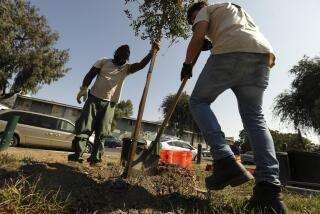The Nature of Historical Monuments
In considering the Los Angeles area’s historical monuments, the image that comes to mind is that of distinguished, dated buildings.
There is the Leonis Adobe, a Monterey-styled, Queen Anne-decorated evocation of early Southern California at 23537 Calabasas Road in Woodland Hills, or the modest Mission-styled Plaza Church, standing proud since 1822 at 535 N. Main St. downtown.
The adobe and the church were in the first group of structures declared historic monuments by the city’s Cultural Heritage Board when it was established 25 years ago.
Since then the board, with the concurrence of the City Council, has declared some 323 monuments--the latest being the Landfair apartments at 10940-10954 Ophir Drive in Westwood, designed in the distinctly modern style by Richard Neutra, and Eastlake Inn, 1442 Kellam Ave., a Victorian delight on Angelino Heights that is now a bed-and-breakfast inn.
But over the years, the board has also declared as monuments a rich variety of trees and palms.
Among those cited is a marvelous Moreton Bay fig tree, on the south side of National Boulevard a few steps west of Military Avenue in the Palms section of West Los Angeles. When declared a monument, it was described by the board--now called a commission and administered by the city’s Cultural Affairs Department--as “the greatest of Australian avenue trees.”
Besides lending grace and shade to the streets, and value to the homes thereon, trees in Los Angeles stand as a reminder of the city’s past and its promise of a new arcadia. Most were planted in the century’s first four decades as a gesture to the future, or later as a mark of community stability and pride.
Stands of trees to have been declared monuments include the deodars lining White Oak Avenue between San Fernando Mission Boulevard and San Jose Street in Granada Hills; the peppers on Canoga Avenue in Woodland Hills, from Ventura Boulevard to Saltillo Street; and the olives on Lassen Street between Topanga Canyon Boulevard and Farralone Avenue in Chatsworth.
Also cited have been the marvelous Washingtonia and queen palms towering above Highland Avenue between Wilshire Boulevard and Melrose Avenue, on the edge of Hancock Park; the cedars lining Los Feliz Boulevard between Riverside Drive and Western Avenue in Los Feliz; and the corals on the median strip of San Vicente Boulevard in Brentwood.
The coral tree, incidentally, is the official tree of the city.
One that obviously was not planted is a proud oak tree on Louise Avenue, about 200 feet south of Ventura Boulevard in Encino. Its age has been estimated at more than 1,000 years, according to the commission.
Another feature of the Los Angeles landscape to have been cited as historically monumental is rock outcroppings. Examples include Stoney Point, east of Topanga Canyon Boulevard in North Chatsworth, and Eagle Rock, at the top of Figueroa Street in, of course, Eagle Rock. The latter was first noted by Spanish explorers, according to the commission, which declared it city monument No. 10 in 1962.
These little tidbits of information are included in a new brochure marking the commission’s 25th anniversary, which was celebrated Thursday. The brochure can be obtained in person at Room 1500 of City Hall, 200 N. Spring St.; there is no charge, but donations to the Cultural Affairs Trust Fund will be gratefully accepted, according to the commission.
Also marking the anniversary is an exhibit of photographs by Julius Shulman and Bruce Boehner documenting many of the monuments. It can be seen at the Bridge Gallery in City Hall Monday through Friday, 8 a.m.-5:30 p.m., until the end of the month.
More to Read
The biggest entertainment stories
Get our big stories about Hollywood, film, television, music, arts, culture and more right in your inbox as soon as they publish.
You may occasionally receive promotional content from the Los Angeles Times.










